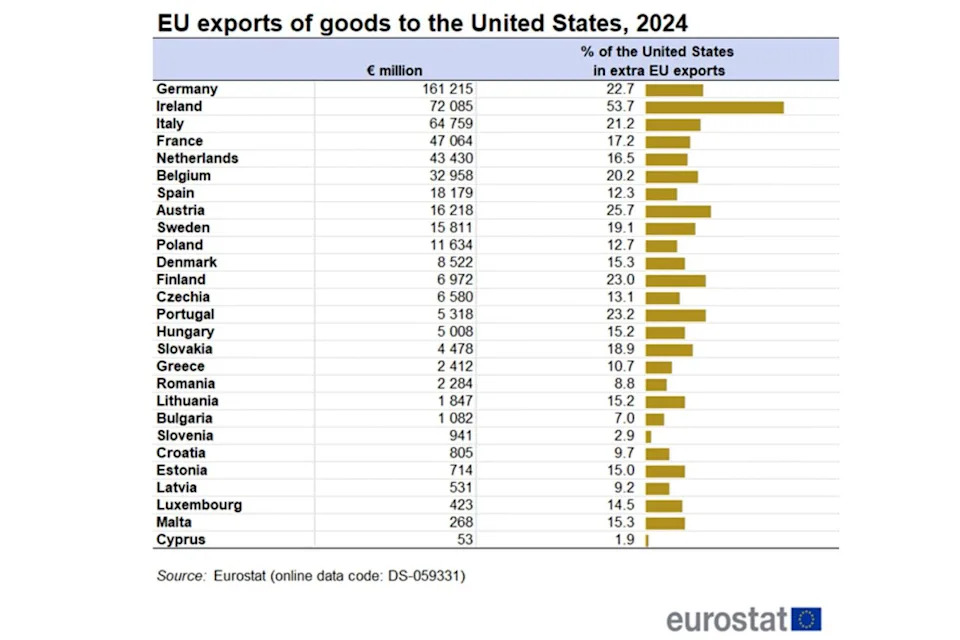Hours after it was revealed that Germany's GDP had performed unexpectedly well in the first quarter—largely driven by strong exports—the future prospects of Europe’s largest economy, and indeed the wider bloc, collapsed dramatically.
US President Donald Trump lost patience last Friday, stating in a social media post that trade negotiations with the European Union were “going nowhere.” He threatened to impose a 50% tariff on EU goods imported into the United States, effective from 1 June.
Subsequently, after talking with European Commission President Ursula von der Leyen over the weekend, he postponed imposing the enormous tariff until 9 July 2025, provided no agreement is reached before then.
“Europe is ready to advance talks swiftly and decisively,” Von der Leyen said. “To reach a good deal, we would need the time until July 9.”
Good call with POTUS. The EU and US share the world’s most consequential and close trade relationship. Europe is ready to advance talks swiftly and decisively. To reach a good deal, we would need the time until July 9.
— Ursula von der Leyen (@vonderleyen.ec.europa.eu) 2025-05-25T19:59:09.931Z
Related
What would a 50% tariff mean to the EU economy?
Given that the US was the largest partner of EU exports of goods in 2024 (20.6%), worth more than €530bn in 2024, according to Eurostat, the impact of such a tariff is sizeable.
Most analysts agree that it would certainly result in a recession in the eurozone, triggering the European Central Bank to cut the key interest rates further than previously expected.
“A 50% tariff could substantially hamper growth and prompt the ECB to continue its monetary easing,” analysts from private banking and investment house Edmond de Rothschild said in an email.
“If the US administration proceeds with its threat of 50% tariffs on EU goods, and the EU responds with a delayed and more limited retaliation, a more accommodative monetary policy stance than the currently forecast would be warranted,” analysts from Barclays said in an email, adding that it could potentially trigger a deep recession in the eurozone which “would likely force ECB's rates closer to ZLB [when short term interest rates hit zero, ed.]”.
Before the US President’s threat, the European Commission lowered its economic forecast, factoring in not only the potential 10%-20% tariffs but the major impact of uncertainty. That also affected the latest eurozone PMIs, which started declining, showing contraction in services, while the manufacturing sector was holding up better.
However, manufacturing is among the key sectors that are prone to suffer should the US impose high tariffs on EU goods.
According to a recent report by Eurostat, the most important goods traded by the EU and the US are medical and pharmaceutical products for exports, and petroleum for imports.
The EU’s top 5 most exported groups of goods in 2024 made up half (49.5%) of all exports to the United States. The top exports were medicinal and pharmaceutical products (22.5%), with their value reaching nearly €120bn last year. This category was followed by road vehicles (9.6%), worth almost €51bn. (The EU already faces 25% US import tariffs on its steel, aluminium and cars.)
The European aircraft sector, including Airbus, is also expected to come into the crosshairs of the US. Previously, the EU put Boeing on its proposed list of US products worth €95bn that could be hit with EU counter-tariffs in case of no deal.
In total, the EU GDP could be hit by 0.5%, according to Maria Demertzis, the head of the economy strategy centre at the Conference Board think-tank in Brussels, cited by the FT.
She based her forecast on a previous study by the European Commission that counted on 20% tariffs lowering EU GDP by around 0.2% annually, driven mainly by weaker exports.
Which EU countries are the most impacted by US trade tariffs?
The EU countries that export the most to the US, therefore the most vulnerable to such tariff hikes, include Germany, Ireland, Italy and France.
Germany was the largest exporter of goods to the United States in 2024, due to the high volume of vehicle exports and pharmaceutical products.
Ireland is mainly exposed through its pharma sector, as many such companies have factories in Ireland where taxes are low. Italy is also among the vulnerable member states, with high exposure in transport equipment, car manufacturing, fashion and pharmaceuticals.

Analysts expect volatility in the markets in the little more than one month left for the negotiations to yield. Previously, the EU showed signs that the current 10% is potentially going to stay. “It is clear from our discussions with the Commission that it will be difficult to go below 10% US tariffs,” a European diplomat told Euronews last week before the US President’s latest threat.
Meanwhile, the European Trade Commissioner Maroš Šefčovič was due to speak with his US counterparts on Monday afternoon.





